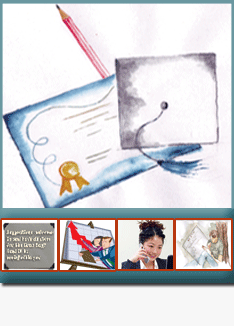|

|
|
You might think study-abroad programs offer only liberal arts courses: foreign languages, culture, art, and literature, for example. But students interested in mixing coursework in math and computer science with international experience also have opportunities, including some that are unique to these two disciplines.
The Math in Moscow program, for example, allows students to study at the Independent University of Moscow and choose among more than 25 undergraduate- and graduate-level courses in math or computer science. The courses are taught in English.
And every semester, the American Mathematical Society awards $7,500 scholarships to five students in the Math in Moscow program.
|
 |
|
To be eligible for the scholarships, students must apply to both the Math in Moscow program and the scholarship. For the spring semester, the application deadline is September 30 for both the program and the scholarship. For the fall semester, the application deadlines are March 30 for the program and April 15 for the scholarship.
For more information about the Math in Moscow program or to get an application, contact the Math in Moscow's U.S. office at P.O. Box 524, Wynnewood, Pennsylvania 19096 or see www.mccme.ru/mathinmoscow. For information about the American Mathematical Society scholarships, write to 201 Charles Street, Providence, Rhode Island 02904; call toll free, 1 (800) 321–4AMS (4267), or, in Rhode Island, (401) 455–4000; or visit online at
|
|
 |
What's happening with working women? A databook from the U.S. Bureau of Labor Statistics (BLS) provides answers to that question.
According to the data, the proportion of women in the workforce increased from about 43 percent in 1970 to 59 percent in 2006. Women's earnings have also risen relative to men's: In 1979, full-time female workers made roughly 62 percent of what their male counterparts did—but that ratio had risen to about 81 percent by 2006.
The growth in women's wages and labor force participation have occurred simultaneously with increased education.
|
 |
|
In 1970, about 11 percent of women in the labor force had bachelor's degrees, compared with about 34 percent in 2006.
BLS data also show the occupations in which women work. For example, in 2006, women made up nearly 51 percent of management and professional workers. Women dominated in some of those occupations, making up 95 percent of speech-language pathologists and 83 percent of social workers. But women were underrepresented in other occupations, such as engineering managers, of which women were only 7 percent of workers.
For more statistics from "Women in the Labor Force: A Databook," write to the BLS Current Population Survey, 2 Massachusetts Avenue NE., Suite 4675, Washington, DC 20212; call (202) 691–6378; or view the report online at www.bls.gov/cps/wlf-databook2007.htm.
|
 Top Top
|
|
|
|
|
|
 |
|
Tech prep or college prep? The National Academy Foundation can give your high school both.
To better prepare students for careers, the foundation creates small learning communities, called academies, within high schools. These academies focus on 1 of 3 career fields: finance, hospitality and tourism, or information technology. Plans have begun for opening an engineering academy in September 2008.
In partnership with nearby employers, each academy offers courses to supplement the traditional curriculum and paid internships to provide students with a chance to apply their classroom learning to a work setting.
|
 |
Statistics show the program's success. More than 90 percent of academy students graduate from high school, and the same percentage said that attending an academy helped them develop their career plans. Eighty percent of academy alumni continue their education at a 2- or 4-year college; 52 percent complete a 4-year college degree.
To learn more about the academies, including how to start one at your school, write to the National Academy Foundation, 39 Broadway, Suite 1640, New York, New York 10006; call toll free, 1 (800) 853–2223, or, in New York, (212) 635–2400; or browse online at www.naf.org. |
 Top Top
|
|
|
|
|
 |
|
Employers are hoping that money talks to 2008 college graduates. According to the National Association of Colleges and Employers (NACE), nearly 54 percent of surveyed employers said they planned to use signing bonuses to attract young talent.
That news is good for grads, but it may get better: If recent trends hold true, even more employers may actually offer bonuses. In 2007, about 47 percent of employers said they planned to offer signing bonuses, and more than 54 percent did. And in the
2006 survey, 44 percent planned to offer bonuses, but 47 percent did.
Another piece of good news for this year’s graduates is that the size of the |
 |
|
average bonus may increase. Employers who said that they plan to offer bonuses this year estimated a bonus of $4,450, on average. That’s a
25-percent increase over the 2007 average of $3,568.
For more information about this or other NACE studies, write to the National Association of Colleges and Employers, 62 Highland Avenue, Bethlehem, Pennsylvania 18017; call toll free, 1 (800) 544–5272; or visit its Web site,
www.naceweb.org. |
 Top Top
|
|
|
|
|
 |
|
Imagine using products created for the aerospace industry—to build a forearm. Or placing a computer chip in an artificial knee to increase range of motion. These are among the tasks you might do if you pursue a career in orthotics and prosthetics.
Orthotics and prosthetics workers create replacement limbs or strengthen existing ones using materials that are both strong and light. These workers’ efforts allow patients new possibilities for movement and independence.
BLS projects that jobs for orthotists and prosthetists will grow by about 12 percent, about as fast as the average for all occupations through 2016. Among the occupations within the field are |
 |
|
practitioners, pedorthists, assistants, fitters, and technicians. Education and training requirements vary.
To learn more about careers in orthotics and prosthetics, write to the American Academy of Orthotists and Prosthetists,
526 King Street, Suite 201, Alexandria, Virginia 22314; call (703) 836–0788; or visit online at www.opcareers.org. |
 Top Top
|
|
|
|
|



